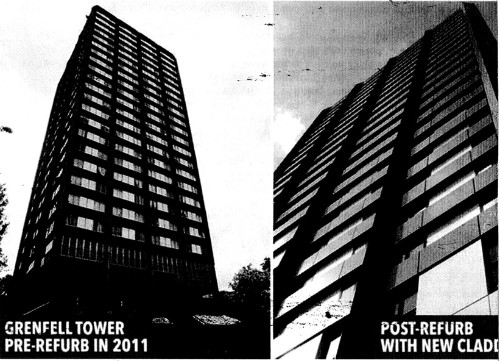Registered with the Registrar of Newspapers for India under R.N.I 53640/91
Vol. XXVII No. 6, July 1-15, 2017
Not strictly Madras, but a warning to all of us
by Neal Baker
Death trap decor
Was cladding to blame for London tower fire?

Colourful green and blue panels designed to improve insulation and soften the looks of the brutalist concrete block were fitted to Grenfell Tower in Kensington, West London, as a part of a £10 million refurbishment in May 2017. Dense foam boards coated in zinc rainproof sheets were spaced 30 mm apart across the 24-storey building, which housed 120 flats and at least 500 residents.
Residents claimed cladding on the outside of the building was responsible for spreading the deadly fire so quickly. And experts confirm the composite foam sandwich panels helped spread the fire quickly from the lower floors all the way up the block.
Material used in the cladding on Grenfell was the cheaper, more flammable version of the two available options, an investigation of the supply chain by The Guardian has claimed.
Arnold Tarling, 55, of the Association of Specialist Fire Protection, said the foam “went up like matchsticks”. And, he said, the waterproof zinc coating made it even harder for firefighters to douse the blaze.
He said: “They clad the concrete of the building with flammable insulation panels and rain screen cladding with a 30 mm gap, which acted like a chimney. All the burning material falls down, starting more fires below, and the flames spread up and across searching for oxygen. Meanwhile, crews can’t tackle the fire effectively because their water just bounces off the rain covers.
“The cladding looks lovely, it’s cheap, complies with regulations and gives the building a high environmental rating. But it’s a silent killer.” He added, “when this block was built, it complied with the old fire regulations. Had it been left alone, it would never have burned like this.”
It is now been claimed that the “death trap” cladding is banned in America – and a fireproof version could have cost just £5,000 more.
When six people died in a 2009 fire at Lakanal House, a 14-storey block in Camberwell, South-east London, exterior cladding panels ignited in just four-and-a-half minutes.
The sub-contractors who carried out the cladding work were paid £2.6 million to oversee the installation. A spokesman for the Company told The Sun: “Harley Facades Limited completed the refurbishment work to Grenfell Tower. This included the installation of exterior cladding.
“The Aluminium Composite Material (ACM) panels are a commonly used product in the refurbishment industry. But Harley Facades Limited do not manufacture these panels.”
Similar cladding to that used at Grenfell Tower has been fitted to high-rise blocks across Britain and the rest of the world. Numerous schemes have made use of cheap insulation to get green energy ticks next to developments. Brightly coloured exterior panelling can be seen on new buildings and added to existing crumbling estates.
Devastating consequences linked to the design craze have been seen in Dubai, where there have been several major blazes. On New Year’s Eve in 2015, a fire tore through the 63-storey Address Hotel. Fortunately no one was killed but it left the building in ruins. There were also fire at the 826 feet Marina Torch residence in February 2015 and at the Tamweel Tower in November 2012. Experts say there are more examples of the cladding’s use in West Asia and China.
Editor’s Note: This article was sent to use by architect Krish Chitale with the question: Is such cladding being used in India, in Madras?

